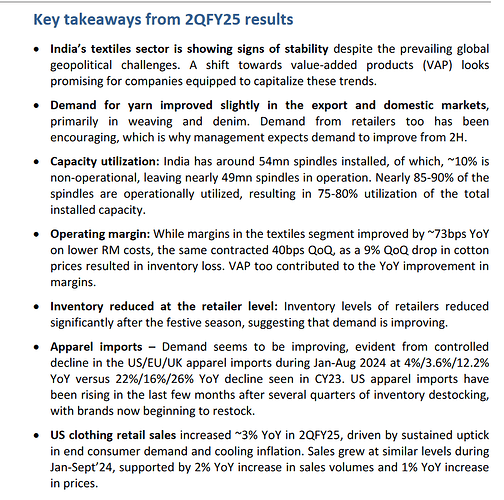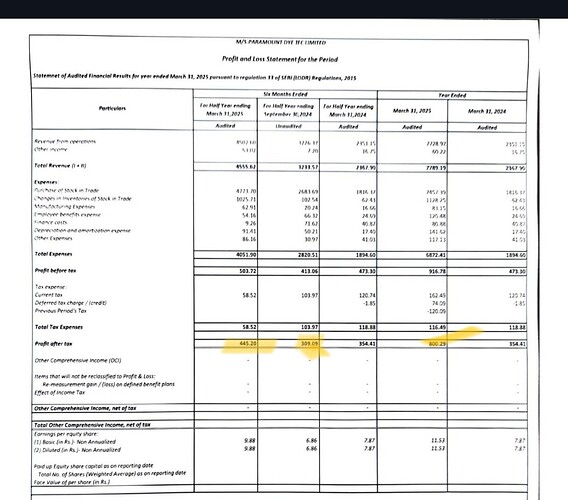Business Model
Paramount Dye Tec Limited operates through two primary activities: manufacturing and trading, focusing on synthetic fibers and yarns. Here’s an overview:
- Manufacturing Operations
- Produces synthetic fibers, particularly recycled acrylic yarns used in sweaters, mufflers, caps, and socks.
- Yarns are made by processing waste from virgin synthetic fiber manufacturers.
- Contributes 65% of FY24 sales with a 22% EBITDA margin.
- Since they use recycled fibres, their raw material procurement costs are significantly lower than virgin fibre yarn manufacturers and thus their EBITDA margins are higher.
- Trading Operations
- Trades in various yarn types, such as acrylic cloth, blended yarn, nylon, and polyester yarns.
- Includes domestic sales and surplus raw materials from manufacturing.
- Contributes 35% of FY24 sales with a 5% EBITDA margin.
Note: While the primary focus is expanding the manufacturing unit, trading continues to maintain customer relationships and handle bulk orders.
Capacity and Utilization
- Fiber Capacity:
- 3600 MT annually (12 MT/day x 300 days on a 12-hour shift).
- Capacity doubled from FY22 to FY23, with EBITDA increasing 4x.
- Current utilization: 95%.
- Company is producing excess recycled fibres as their yarn capacity is fully utilized so they have to sell the excess stock or store it as inventory
- Yarn Capacity:
- Current: 1440 MT (4.8 MT/day x 300 days) with 97% utilization.
- Planned by FY25-end: 3540 MT (7 MT/day + 4.8 MT/day) using funds received from IPO in Oct-24, a 2.5x increase.
- Company had already given orders for the new machines as per the RHP
- The company has started laying the wires and transformers in mid-Nov with machines expected by end of Nov. Production to start in Q1FY25.
Key Financial Highlights
-
Cash Flow:
- CFO/EBITDA ratio: 11%, with positive operating cash flow.
- Trade Receivables: ₹6.05 Cr (mostly <6 months old) and largely secured.
- Inventory Levels: ₹17.5 Cr, including ₹7.7 Cr in raw materials and ₹4.2 Cr in unsold finished goods due to excess fibre being produced.
-
Peer Comparison:
| S No | Company Name | MCap | Land | PAT | PE | Gross Margin | MCap (Adj. for Land) | PE (Adj.) |
|---|---|---|---|---|---|---|---|---|
| 1 | Paramount | ₹67.7 Cr | ₹13 Cr | ₹6.3 Cr | 10.7 | 50% | ₹54.7 Cr | 8.7 |
| 2 | Indian Acrylic | ₹170 Cr | ₹3 Cr | -₹53 Cr | -3.2 | 30% | ₹167 Cr | -3.2 |
| 3 | Nitin Spinners | ₹2195 Cr | ₹16 Cr | ₹132 Cr | 16.6 | 34% | ₹2179 Cr | 16.5 |
| 4 | GHCL Textiles | ₹910 Cr | ₹211 Cr | ₹25 Cr | 36.4 | 31% | ₹699 Cr | 28.0 |
| 5 | Sportking | ₹1503 Cr | ₹24 Cr | ₹70 Cr | 21.5 | 24% | ₹1479 Cr | 21.1 |
Additional Observations
- There seems to be a discrepancy in the land value reported in RHP (₹12.8 Cr) vs. screener data.
- Increasing demand for acrylic yarn positions Paramount well, but margins and multiples compared to peers need closer monitoring.
Promoter
- He comes across really well in his interviews, showcasing a clarity of thought. Has ambitions to increase production to 100 MT per day eventually
- A really good YouTube video with his interview: https://www.youtube.com/watch?v=ITgfJNFHZJg
- Personally, whenever, I have reached out regarding some questions, he has been really forthcoming and prompt even on late Sundays.
- The remuneration seems fair
Risks and Concerns
- Concentration Risk: Although, this is because the company is really small and doesn’t need to diversify yet.
- Top 10 suppliers account for 100% of purchases.
- Top 10 customers contribute 78.18% of revenue.
- Promoter-Related Risks
- Promoter company is engaged in a similar line of business of cotton yarn recycling and manufacturing. Future plans, including potential acquisitions, remain unclear.
- Raw Material Volatility
- Prices of key inputs like acrylonitrile fluctuate, impacting pricing and margins. Competitors with better production efficiency or superior quality may erode market share.
- Seasonality in Demand
- Seasonal dependence exists, but capex from IPO proceeds targets expanding into the summer wear market.
- Planned portfolio includes blends of acrylic-cotton, cotton-polyester, and other materials for t-shirts, shorts, and polos, mitigating seasonality risks.
Industry Outlook: Textile industry going through major tailwinds.
Source: Systematix Institutional Equities
Areas to Monitor
- Raw material price fluctuations.
- Execution of capex plans and their impact on mitigating seasonality risks.
- Competitive landscape, especially regarding peer gross margins and efficiency.
Disclosure: I am invested in this stock. Please do your own due diligence before investing


